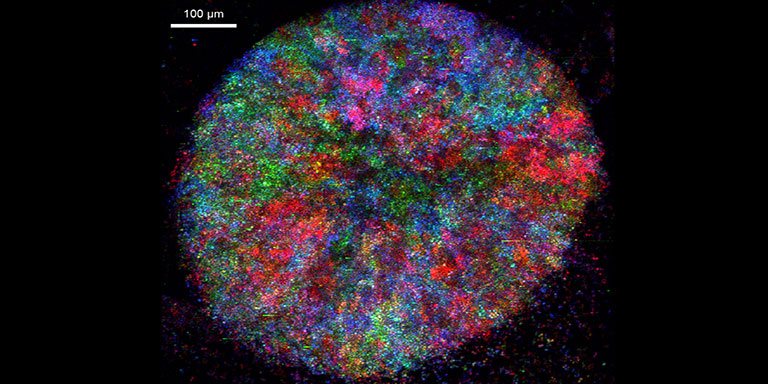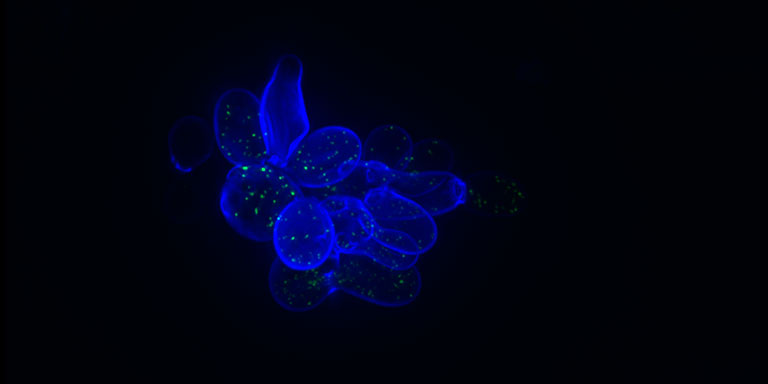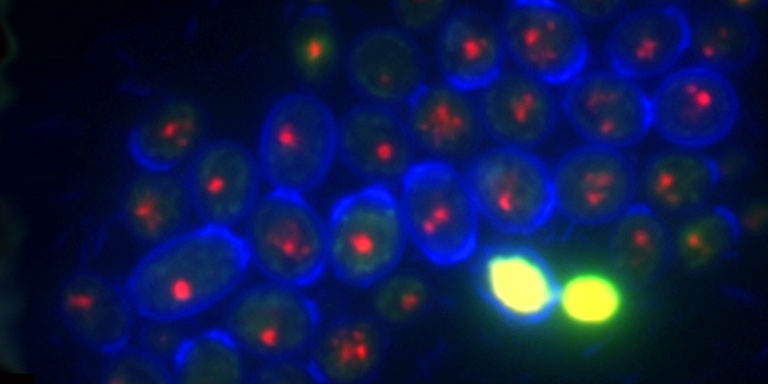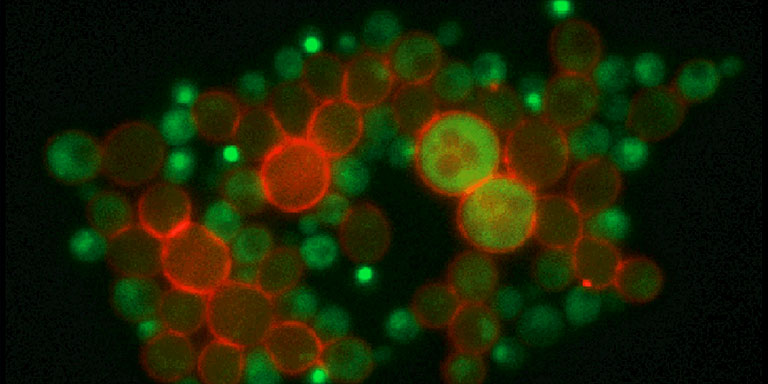-
 Varying metabolic activity within a yeast colony
Varying metabolic activity within a yeast colony
Image courtesy of Dr. Kate Campbell, Ralser Lab, University of Cambridge -
 Localization of Erg1-GFP to lipid droplets in stationary phase cells
Localization of Erg1-GFP to lipid droplets in stationary phase cells
Image courtesy of Sébastien Léon, Institut Jacques Monod/ CNRS - Paris, France. -
 Rap1-GFP and Calcofluor White staining of stationary phase cells.
Rap1-GFP and Calcofluor White staining of stationary phase cells.
Image courtesy of M. Guidi, M. Ruault and A. Taddei, Institut Curie (Paris). -
 Pma1-mCherry and Vma1-GFP localization in mitotic cells.
Pma1-mCherry and Vma1-GFP localization in mitotic cells.
Image courtesy of M. Eastwood, Fred Hutch and M. Meneghini, University of Toronto. -
 CCCP-induced decrease of mitochondrial membrane potential (below) or control treatment (above) as measured by MitoLoc.
CCCP-induced decrease of mitochondrial membrane potential (below) or control treatment (above) as measured by MitoLoc.
Image courtesy of Dr. Jakob Vowinckel, Ralser Lab, University of Cambridge. -
 Large sized lipid droplets in aged wild-type BY4741 cells
Large sized lipid droplets in aged wild-type BY4741 cells
Image courtesy of D.K. Vijayan, R. Rajasekharan and M. Srinivasan, CSIR-CFTRI, India -
 Redistribution of Msn5 pools from the nucleus to the cytoplasm upon glucose deprivation.
Redistribution of Msn5 pools from the nucleus to the cytoplasm upon glucose deprivation.
Image courtesy of H. Huang and A. Hopper, Ohio State University. -
 Floccule of yeast rho0 cells expressing PTS1-GFP as a peroxisomal marker, stained with calcofluor white.
Floccule of yeast rho0 cells expressing PTS1-GFP as a peroxisomal marker, stained with calcofluor white.
Image courtesy of Dr. Jakob Vowinckel, University of Cambridge -
 S. cerevisiae membrane proteins visualized by RFP and GFP.
S. cerevisiae membrane proteins visualized by RFP and GFP.
Image courtesy of Masur. Wikimedia Commons. -
 Peroxisome (red) and mitochondrial (green) fission defects in vps1 fis1 double deletion strain transformed with FIS1.
Peroxisome (red) and mitochondrial (green) fission defects in vps1 fis1 double deletion strain transformed with FIS1.
Image courtesy of S. Lefevre, S. Kumar and I. van der Klei, University of Groningen. -
 Yeast cells expressing TRK1/GFP.
Yeast cells expressing TRK1/GFP.
Image courtesy of V. Zayats and J. Ludwig, Center of Nanobiology and Structural Biology, AV CR. -
 The distribution of mtDNA (green) within the mitochondrial network (red).
The distribution of mtDNA (green) within the mitochondrial network (red).
Image courtesy of Christof Osman and Peter Walter, University of California, San Francisco -
 The distribution of ER exit sites (ERES, green) within the ER (red).
The distribution of ER exit sites (ERES, green) within the ER (red).
Image courtesy of A. Nakano and K. Kurokawa, RIKEN. -
 Cell, actin and nuclear morphology of yeast cells treated with DMSO (left) and poacic acid (right).
Cell, actin and nuclear morphology of yeast cells treated with DMSO (left) and poacic acid (right).
Images courtesy of Hiroki Okada and Yoshikazu Ohya, University of Tokyo. -
 Localization of active Ras in a wild type strain
Localization of active Ras in a wild type strain
Image courtesy of S. Colombo and E. Martegani, University Milano Bicocca -
 Sectored colonies showing loss of silencing at the HML locus
Sectored colonies showing loss of silencing at the HML locus
Image courtesy of Anne Dodson, UC Berkeley -
 Pma1p imaged using the RITE tagging system in mother (green) and daughter cells (red)
Pma1p imaged using the RITE tagging system in mother (green) and daughter cells (red)
Image courtesy of Dan Gottschling Ph.D., Fred Hutchinson Cancer Research Center -
 San1 strain visualized with FUN and calcofluor white
San1 strain visualized with FUN and calcofluor white
Image courtesy of the Bruschi lab, ICGEB, Trieste, Italy -
 Single MDN1 mRNAs detected by FISH
Single MDN1 mRNAs detected by FISH
Image courtesy of the Zenklusen Lab, Université de Montréal -
 Localization of Ace2-GFP to daughter cell nuclei
Localization of Ace2-GFP to daughter cell nuclei
Image courtesy of Eric Weiss, Ph.D. Northwestern University
About SGD
The Saccharomyces Genome Database (SGD) provides comprehensive integrated biological information for the budding yeast Saccharomyces cerevisiae along with search and analysis tools to explore these data, enabling the discovery of functional relationships between sequence and gene products in fungi and higher organisms.
Upcoming Meetings
2016 Southeastern Regional Yeast Meeting (SERYM 2016)
March 25, 2016 - The University of Alabama, Tuscaloosa, AL, USA
Registration and abstract submission deadline: February 29, 2016Yeasts, Models and Tools 2016
April 13, 2016 - Brussels, Belgium
Registration and abstract submission deadline: February 16, 2016
Late registration and abstract submission still possibleGene transcription in yeast: From chromatin to RNA and back
June 11, 2016 - Sant Feliu de Guixols, Spain
Abstract deadline: March 14, 2016PYFF6 - 6th Conference on Physiology of Yeast and Filamentous Fungi
July 11, 2016 - University of Lisbon, Lisbon, Portugal
Yeast Genetics Meeting at TAGC 2016: The Allied Genetics Conference
July 13, 2016 - Orlando, FL
Abstract and early registration deadline: March 23, 2016
New & Noteworthy
- The Benefits of Sex
03/03/2016
While you doggedly swipe right and left or wait night after night at that club, you may be wondering whether it is all worth it. Biologists have been wondering something similar. Now they haven’t been wondering about the value of sex…since everything from amoebas to zebras has sex, it must be pretty important. No, the hard part has been figuring out why it is so beneficial. On balance it can seem that the minuses of disease risk... Read... - Join SGD at The Allied Genetics Conference
02/29/2016
SGD will be attending The Allied Genetics Conference (TAGC) in Orlando, Florida, July 13–17, 2016! For the first time ever, the meetings of the yeast, C. elegans, ciliate, Drosophila, mouse, and zebrafish model organism communities will be united under one roof, along with a new meeting on population, evolutionary, and quantitative genetics. Submit your abstracts now! Abstract submission will be open until March 23, 2016. If you want GREAT science and access to the leaders of... Read... - Not Quite The Same
02/24/2016
Imagine a world where you either make your own bread from scratch or have it delivered to your doorstep. Not much of a difference, right? Either way you’re eating bread. Except of course that the two are pretty different. Having your bread delivered frees up time to do other things. It turns out that something similar may be going on in our old friend, Saccharomyces cerevisiae. According to a new study in Nature Microbiology by Alam... Read... - Unlocking Chromatin
02/10/2016
In Die Hard, Hans Gruber and associates need to break through seven locks in the right order on a safe to get to bearer bonds worth 640 million dollars. Of course the hero John McClane foils the plot and beats the villains. Nothing so exciting in yeast, but some genes are nearly as hard to turn on as that safe was to open. One of the most stubborn is the HO gene. It requires three locks... Read...